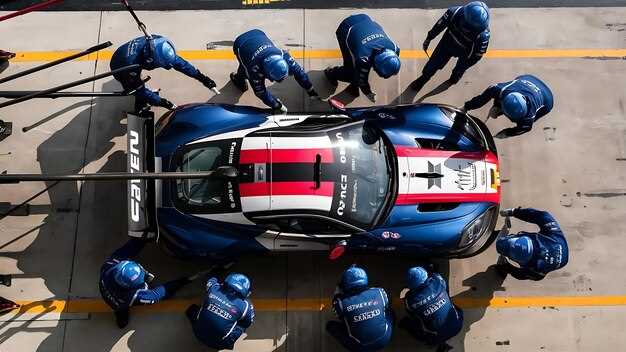
The 24 Hours of Le Mans is more than just a race; it is a celebration of automotive engineering and human endurance. Held annually in the picturesque town of Le Mans, France, this iconic endurance race has captivated motorsport fans since its inception in 1923. As one of the most prestigious events in the world, the Le Mans race tests not only the speed and performance of vehicles but also the resilience and strategy of the teams involved.
What sets the 24 Hours of Le Mans apart from other racing competitions is its unique format. Over the course of a grueling day and night, teams must navigate a balanced approach between speed and endurance. Drivers and their machines face countless challenges including varying weather conditions, tire degradation, and the physical and mental strain of racing non-stop for 24 hours. This extreme test of durability creates a thrilling spectacle that resonates with fans around the globe.
The allure of the Le Mans race lies in its rich history and tradition. From legendary battles between manufacturers to groundbreaking innovations in automotive technology, the event has consistently delivered unforgettable moments. For motorsport fans, the 24 Hours of Le Mans is not just a race; it is a testament to the spirit of competition and the relentless pursuit of excellence in the world of endurance racing.
The Thrill of Endurance Racing Challenges

The 24 Hours of Le Mans represents the pinnacle of endurance racing, where the race extends beyond sheer speed to test the limits of both man and machine. This unique challenge requires teams to maintain peak performance for an entire day, fostering a gripping atmosphere that captivates motorsport fans worldwide.
Endurance racing introduces a multitude of factors that contribute to its thrill. Drivers must exhibit not only skill but also resilience, navigating the grueling hours of track time while managing fatigue and mental strain. The strategic aspect of le race is equally compelling, as teams balance tire management, fuel consumption, and pit stop strategies to maximize their chances of victory.
The unpredictable nature of endurance events adds another layer of excitement. Weather changes, mechanical failures, and on-track incidents can dramatically alter the race’s outcome, keeping fans on the edge of their seats. Such elements create unexpected turns that highlight the necessity for adaptability and quick thinking among the teams.
Moreover, the camaraderie built within teams throughout these long hours intensifies the emotional investment for fans. The collaborative effort required to succeed reinforces a sense of unity, underscoring the spirit of endurance racing that resonates deeply with audiences.
In conclusion, the thrill of endurance racing challenges lies in its intricate blend of strategic planning, driver stamina, and the ever-present potential for unpredictability. It transforms standard motorsport into a breathtaking spectacle that draws enthusiasts and casual viewers alike, ensuring that events like Le Mans remain cherished icons in the world of racing.
Historic Moments That Shaped Le Mans Legacy
The 24 Hours of Le Mans has been the stage for numerous historic moments that have defined the endurance racing landscape. One of the most significant events took place in 1966 when Ford made headlines by finally defeating Ferrari, a victory that marked a turning point in automotive competition. This race showcased the fierce rivalry and innovation that has characterized Le Mans for decades.
In 1970, the Le Mans race was tragically overshadowed by the fatal accident of driver Jo Schlesser, which triggered discussions about safety in motorsport. This prompted the introduction of stricter safety regulations, establishing a legacy of prioritizing driver well-being during endurance races.
The iconic 1988 race also left an indelible mark on the history of Le Mans, as the top three cars were all from the same manufacturer, Mazda. This extraordinary event highlighted the importance of innovation and engineering mastery in endurance racing. Mazda’s victory was especially remarkable because it was the first time a vehicle powered by a rotary engine clinched the top spot, demonstrating the necessity of unconventional strategies in a highly competitive environment.
In the 1990s, the rivalry between Audi and Porsche intensified, leading to incredible advancements in technology. Audi’s dominance starting in 2000 with their revolutionary diesel engines showcased the shift towards efficiency without compromising performance, setting a precedent for future endurance races.
Le Mans has continuously captivated fans not only through thrilling races but also through moments that have changed the course of automotive history. The essence of endurance racing lies in these unforgettable stories, each contributing to the rich tapestry of the event’s legacy.
The Role of Technology in Modern Competitions

In the world of motorsport, technology has become a cornerstone of competition, significantly shaping the dynamics of events like the 24 Hours of Le Mans. The integration of advanced engineering and innovative materials enhances vehicle performance, providing teams with a competitive edge essential for success in such grueling races.
Le Mans race teams utilize cutting-edge aerodynamics to optimize car stability at high speeds. Wind tunnel testing and computational fluid dynamics enable engineers to refine shapes that reduce drag and increase downforce, allowing cars to navigate the challenging circuit more effectively. These advancements directly impact lap times and overall race strategy.
Moreover, hybrid powertrains represent another leap forward in technology, combining internal combustion engines with electric systems. This not only improves fuel efficiency but also enhances acceleration and responsiveness on the track. Teams must balance performance with sustainability, making engineering decisions that align with the evolving regulations of modern endurance racing.
Data analytics also plays a vital role in strategy execution during competitions. Live telemetry allows teams to monitor various performance metrics in real time, paving the way for informed decisions regarding pit stops, tire selections, and fueling strategies. The ability to quickly analyze data gives teams an advantage, enabling them to adapt to changing conditions throughout the race.
In summary, the role of technology in modern competitions like the 24 Hours of Le Mans cannot be overstated. From advancements in aerodynamics to hybrid powertrains and data analytics, each aspect contributes to the development of faster, more efficient racing machines. These innovations not only enrich the sporting experience but also keep fans captivated by the ever-evolving nature of motorsport.



